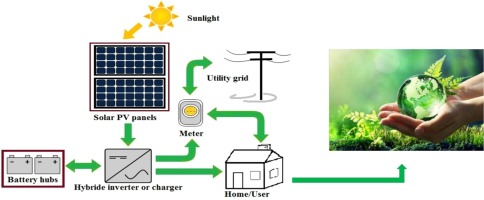
There are Three Prominent Types of Solar PV Systems:
Grid Connected Solar PV System or Electricity Distribution Company-Interactive Systems (Net Metering)
Stand-alone Solar PV Systems
Hybrid Systems
1. Grid-Connected Solar PV System
Grid-connected PV systems do not need to have battery storage. However, it’s always possible to add a battery to a grid-connected solar system.
(A) Grid-Connected PV Systems without Battery
A grid-connected system is a basic installation that uses a grid-tied inverter. It’s ideal for those who wish to opt for solar installation for residential use. Consumers can benefit from net metering. Net metering allows us to redirect any surplus energy to the grid. In this way, customers have to pay only for the difference in energy that they use. A grid-connected system has solar panels that absorb solar radiation, which is then transformed into direct current (DC). The DC is then used by the solar system’s inverter which converts the DC energy to alternating current (AC). The AC can be then used by household devices in the same way they rely on a grid system.
The main advantage of using a grid-connected system is that it is less expensive than other types of solar PV systems. Further, it offers design flexibility as the system need not power all of the household’s loads. The key drawback of a grid-connected system is that it does not offer any outage protection. Examples: Domestic, Commercial, Industrial and Telecom Tower Systems.
(B) Grid-Connected PV Systems with Battery
Including a battery in a grid, PV system offers more energy independence to the household. It leads to reduced reliance on grid electricity and energy retailers along with the assurance that electricity can be drawn from the grid in case the solar system is not generating enough energy.
2. Standalone Solar PV Systems
A standalone PV system (also called an off-grid solar system) is not connected to the grid. Thus, it requires a battery storage solution. Standalone PV systems are useful for rural regions that have difficulty connecting to the grid system. Since these systems don’t rely on electrical energy storage, they are suitable for powering applications such as water pumps, ventilation fans, and solar thermal heating systems. It’s essential to consider a reputed company if you are planning to go for a standalone PV system. This is because an established firm will cover warranties for a longer period. However, if standalone systems are considered for household use, they will have to be designed in such a way that they can address the household’s energy needs as well as the battery charging requirements. Some standalone PV systems also have backup generators installed as an extra layer. Examples: Domestic, and Telecom Tower Systems.
However, such an arrangement can be expensive to set up and maintain.
An overhead associated with standalone solar PV systems is that they require constant checks against terminal corrosion and battery electrolyte levels.
3. Hybrid Solar PV Systems
A hybrid PV system is a combination of multiple sources of power to enhance the availability and usage of power. Such a system can leverage energy from sources such as wind, sun, or even hydrocarbons. Furthermore, hybrid PV systems are often backed up with a battery to maximize the efficiency of the system. There are various advantages of using a hybrid system. Multiple sources of energy mean that the system is not dependent on any particular energy source. For instance, if the weather is not conducive to generating enough solar energy, the PV array can charge the battery. Similarly, if it’s windy or cloudy, a wind turbine can address the charging requirements of the battery. Hybrid PV systems are best suited for isolated places with limited grid connection.
Despite the above advantages, there are a few challenges associated with a hybrid system. For instance, it involves a complex design and installation process. Moreover, multiple sources of energy can increase the upfront costs. Examples: Domestic, Commercial, Industrial and Telecom Tower Systems.
Recommendation
The various PV systems discussed above are useful in different areas of application. So, when it comes to choosing the best, you need to take your usage requirements and budget into account.
